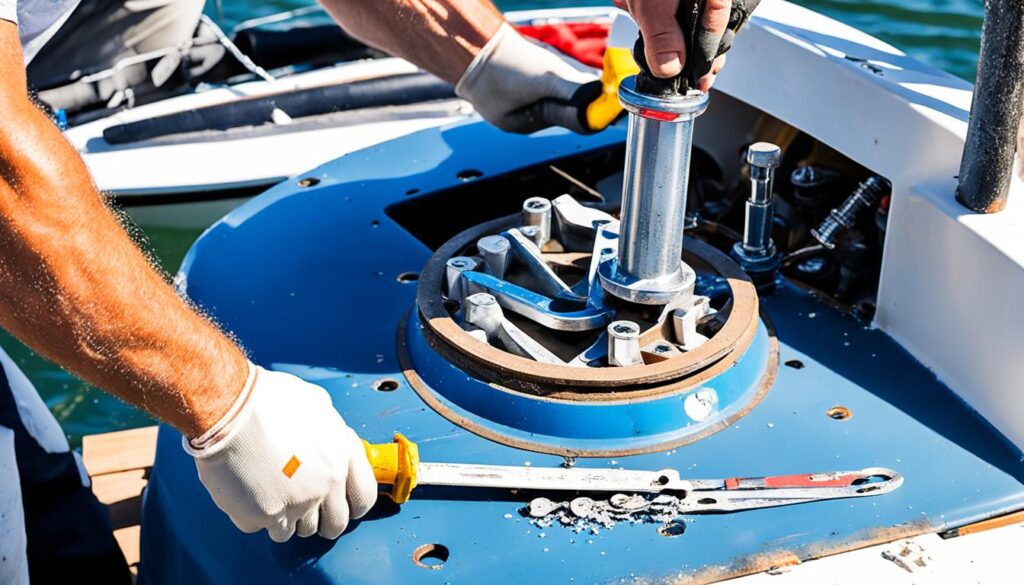Welcome aboard! As a boat owner, regular maintenance and repairs are essential to keep your vessel in great condition and ensure it performs at its best. But hiring professional services can be expensive and time-consuming. That’s where DIY boat maintenance and repair come in. By following some practical tips and tricks, you can perform routine maintenance tasks and even tackle some minor repairs on your own.
In this section, we will introduce you to the world of DIY boat maintenance and repair and provide you with some essential tips and tricks to keep your vessel in top shape, saving you time and money. From routine maintenance tasks to basic and advanced repairs, we’ve got you covered. So, get ready to dive in and become a pro at boat maintenance and repair in no time!
Key Takeaways:
- Regular maintenance is key to the longevity and performance of your boat.
- Choosing the right boat maintenance products is crucial for effective and safe maintenance and repairs.
- Safety considerations should always be a top priority when performing DIY boat maintenance and repairs.
- Following a boat maintenance checklist can help you stay on top of important tasks and prevent costly issues down the line.
- Properly winterizing your boat is essential to protect it during the off-season.
Essential Boat Maintenance Checklist
To ensure your boat stays in top shape, regular maintenance is essential. Whether you’re a new boat owner or experienced seafarer, keeping up with routine maintenance tasks can prevent costly issues down the line. Use the following boat maintenance checklist to help guide your maintenance routine:
| Task | Frequency |
|---|---|
| Inspect hull for damage, cracks, or blisters | Before every trip and at least once per season |
| Clean and check propeller for damage | Every trip |
| Check steering system (including cables and hydraulic systems) | Seasonally and before every trip |
| Check fluid levels (oil, coolant, power steering fluid, etc.) | Monthly or before every trip |
| Check fuel system for leaks and ensure fuel is properly stored and stabilized | Before and after each use, and seasonally if not used frequently |
| Inspect electrical systems (including battery, wiring, and connections) | Seasonally and before every trip |
| Clean and condition interior surfaces | As needed and after every trip |
Following this checklist regularly can help you stay on top of important maintenance tasks and keep your boat running smoothly. Remember to always prioritize safety, wear proper protective gear, and seek professional help for any repairs beyond your skill level.
Troubleshooting Common Boat Maintenance Issues
Regular boat maintenance is essential to avoid issues but sometimes problems can still arise. Knowing how to identify and resolve common maintenance issues will help you get your boat back in great shape quickly and efficiently. Here are some of the most common issues boaters face and some troubleshooting tips to help you handle these problems like a pro:
- Engine Won’t Start: If your engine won’t start, check the battery and fuel system first. Look for loose connections or corroded terminals in the battery and ensure there is enough fuel in the tank. If these checks don’t solve the issue, consult your boat manual or seek professional help.
- Overheating Engine: Overheating can result from a blocked intake or pump, clogged water passages, or a damaged impeller. Check for debris in the intake or pump and clear any blockages that you find. If that doesn’t work, check the water passages and replace the impeller if it’s damaged. If you’re unsure how to do this, consult your boat manual or call in a professional.
- Electrical Problems: Electrical issues can cause a wide range of problems, including dead batteries, faulty lights, and malfunctioning electronics. Check for loose connections or corroded terminals, and ensure all switches are in the correct position. If you’re still having issues, consult your boat manual or a qualified marine electrician.
- Leaking: Leaks can be caused by a wide range of issues, including hull damage, loose fittings, and damaged hoses. Check for signs of damage or wear and replace any damaged components. If you can’t identify the source of the leak, call in a professional for help.
Keeping your boat well-maintained is crucial for ensuring a safe and enjoyable boating experience. By following these troubleshooting tips and techniques, you’ll be able to address common issues and get back to enjoying the water in no time.
Basic DIY Boat Repairs
Boat repairs can be expensive, but with a bit of know-how, you can save money by tackling some repairs yourself. In this section, we will provide you with clear instructions on some basic DIY boat repairs that you can do at home.
1. How to Patch Fiberglass
If your boat has a hole or crack in the fiberglass, you can repair it yourself with a fiberglass patch kit. Start by cleaning the area around the damage with acetone. Cut a piece of fiberglass patch material that is slightly larger than the hole, and apply a layer of epoxy to the damaged area. Place the patch material over the epoxy, and smooth out any air bubbles or wrinkles. Allow the epoxy to dry completely before sanding the area smooth.
2. Replacing a Broken Steering Cable
If your boat’s steering cable is broken, you can replace it yourself with some basic tools. Begin by loosening the cable at both the steering wheel and the engine. Remove the old cable by disconnecting it from both ends, and then attach the new cable in the same way. Tighten the cable at both ends and test the steering to make sure everything is working properly.

Expert Tip: Always read the manufacturer’s instructions carefully before attempting any repairs, and double-check your work before heading out on the water.
Advanced Boat Repair Techniques
While some boat repairs are simple enough for DIY enthusiasts to undertake, others are complex and require professional expertise. However, if you’re confident in your boat repair skills, there are some advanced techniques you can try to tackle more complex issues on your own. In this section, we’ll discuss some tips for repairing your boat like a pro, as well as provide insights into when it’s best to seek professional help.
Know Your Limits
Before you attempt any advanced boat repairs, it’s essential to know your limits. Some repairs, such as those involving the hull or electrical systems, require specialized knowledge and equipment. Attempting these repairs without the necessary expertise can lead to further damage or even injury. Always be honest with yourself about your skills and be willing to seek professional help when needed.
“Attempting advanced boat repairs without the necessary expertise can lead to further damage or even injury.”
Get the Right Tools
To successfully tackle advanced boat repairs, you’ll need the right tools. It’s worth investing in high-quality equipment, such as specialized wrenches, pliers, and diagnostic tools. Make sure you know how to use each tool properly and always follow safety protocols, such as wearing protective gear and ensuring electrical systems are disconnected before working on them.
Research and Plan
Before attempting any boat repair, it’s important to research and plan your approach. Consult your owner’s manual and manufacturer’s guidelines to ensure you’re following the correct procedures. Use reliable online resources or seek advice from professionals to expand your knowledge and make informed decisions about repair methods and materials.
Choose the Right Materials
Selecting the appropriate materials is crucial for effective boat repairs. Different materials, such as fiberglass, aluminum, and wood, require different types of repair techniques and products. Always choose high-quality materials and products that are specifically designed for use on boats. Don’t cut corners by using cheap, lower-quality alternatives, as this can lead to further damage or premature wear and tear.
Remember, it’s always better to be safe than sorry when it comes to boat repairs. If you’re not confident in your abilities or unsure about a repair, seek professional help. By following the tips and techniques provided in this guide, you can expand your boat repair skills and tackle more complex repairs with confidence.
Winterizing Your Boat for Long-Term Storage
As winter approaches, it’s important to protect your boat during the off-season to ensure it’s in great condition when you’re ready to hit the water again. Proper winterization is essential and involves a series of steps to prepare your boat for long-term storage. Follow these boat maintenance and repair tips to keep your boat in top shape:
- Inspect the hull and deck: Check for any signs of damage, including cracks, blisters, or soft spots. Repair any issues before storing your boat.
- Flush the engine: Make sure to properly flush your engine with fresh water and allow it to fully drain before adding antifreeze. Consult your owner’s manual for specific instructions on how to do this.
- Add antifreeze: Drain all water from the engine and add antifreeze to the cooling system to prevent any remaining water from freezing and causing damage.
- Fill up fuel tanks: Top off your fuel tanks to minimize the amount of air inside, helping prevent condensation and fuel contamination.
- Protect the interior: Cover any exposed areas to protect from dust and debris. Remove all electronics and valuables from the boat to prevent theft.
By following these tips and tricks for DIY boat maintenance, you can ensure your boat stays in top shape throughout winter storage. Don’t hesitate to reach out to a professional if you have any questions or concerns.
Cleaning and Detailing Your Boat
After a day on the water, your boat can take a beating. From saltwater to sun exposure, your vessel is exposed to environmental elements that can lead to damage and deterioration. Regular cleaning and detailing are essential to maintain your boat’s appearance and prevent long-term damage. In this section, we will provide you with tips and techniques for cleaning and detailing your boat inside and out.

Interior Cleaning and Detailing
The interior of your boat requires regular cleaning just like your home. Start by clearing out any loose items and debris. Then, wipe down all surfaces with a gentle cleaner to remove dirt and grime. For tough stains, use a specialized marine cleaner and let it sit for a few minutes before wiping away. Don’t forget to clean carpets and upholstery to remove any odors and stains. Finally, finish off by applying a UV protective coating to help prevent sun damage.
Exterior Cleaning and Detailing
When it comes to the exterior of your boat, regular washing is crucial. Use a mild soap and soft brush to remove dirt and salt buildup. For tough stains, use a specialized boat cleaner and a pressure washer. After washing, dry the boat with a chamois to prevent water spots. Polish and wax the exterior to not only make it shine but help protect the gel coat. For ultimate protection against the elements, apply a UV protective coating to the exterior of the boat annually.
Engine and Mechanical Cleaning
The engine and mechanical components of your boat require regular cleaning as well. Start by cleaning the bilge area to remove any oil or debris buildup. Then, use a specialized engine cleaner to remove any buildup or corrosion. Inspect belts and hoses for wear and tear and replace if necessary. Finally, lubricate all moving parts to keep them running smoothly.
Gear and Accessory Cleaning
Don’t forget about your gear and accessories. Clean and inspect all fishing gear, water toys, and safety equipment before storing them. Additionally, check navigational equipment and electronics for any issues or broken parts. By properly maintaining your gear and accessories, they’ll work when you need them most.
By following these boat maintenance techniques for cleaning and detailing your boat, you’ll not only increase its lifespan but also improve its overall appearance. Regular cleaning and detailing will also save you money in the long run by preventing costly damage.
Selecting the Right Boat Maintenance Products
When it comes to boat maintenance, having the right products can make a significant difference in the effectiveness and safety of your maintenance and repairs. With numerous boat maintenance products available in the market, choosing the right ones can be overwhelming.
Here are some boat maintenance essentials you should include in your toolkit:
| Product | Use |
|---|---|
| Marine lubricants: | To keep your boat’s engine and mechanical parts lubricated and running smoothly. From propeller shaft grease to gear lube, ensure to use marine-specific lubricants. Avoid using automotive lubricants, which can damage your boat’s parts. |
| Boat cleaners: | To clean and maintain your boat’s exterior and interior. From boat wash soap to vinyl cleaner, choose marine-specific cleaners that are effective and safe for your boat’s surfaces. |
| Anodes: | To protect your boat’s metal parts from corrosion. Zinc anodes help prevent galvanic corrosion, while aluminum anodes are ideal for boats in saltwater environments. |
| Sealants: | To seal and protect your boat’s surfaces. From marine sealant to polysulfide sealant, use marine-specific sealants that are designed for underwater use and can withstand harsh marine environments. |
Remember to follow the manufacturer’s instructions when using boat maintenance products and wear protective equipment to ensure your safety.
Safety Considerations for DIY Boat Maintenance
Undertaking DIY boat maintenance and repairs can be rewarding and cost-effective, but it’s essential to prioritize safety at all times. Here are some key safety considerations to keep in mind:
Personal Protective Equipment
Wearing the right personal protective equipment (PPE) can prevent injuries when working on your boat. Always wear appropriate clothing, including non-slip shoes, and consider items such as safety glasses, gloves, and a respirator mask.
Proper Use of Tools
Using tools correctly is crucial for both safety and effectiveness. Always read the manufacturer’s instructions and follow safety guidelines when using power tools. Keep cutting tools sharp and clean, and make sure that hand tools are in good condition before use.
Best Practices for Working in Different Areas of Your Boat
Safe work practices can go a long way in preventing accidents when working on your boat. Avoid working alone, and be sure to tell someone where you are and what you’re doing. Make sure the boat is stable and secure, and be aware of your surroundings, including any electrical hazards.
By following these safety considerations, you can focus on achieving top-notch DIY boat maintenance and repairs while ensuring a safe boating experience for yourself and others aboard.
Conclusion
As a boat owner, taking care of your vessel should always be a top priority. By mastering the art of DIY boat maintenance and repair, you can save money on professional services and keep your boat in top shape year-round. We hope this guide has provided you with valuable tips and tricks to help you tackle routine maintenance tasks and even some repairs on your own.
Remember to always prioritize safety when working on your boat and seek professional help when needed, especially for more complex repairs. With proper maintenance and care, your boat will continue to provide you with many enjoyable adventures on the water for years to come.
FAQ
What are some essential boat maintenance tasks I should be doing regularly?
Regular boat maintenance tasks include inspecting the hull for damage, checking the engine oil and coolant levels, cleaning and lubricating moving parts, testing electrical systems, and ensuring proper ventilation on board.
How often should I schedule routine boat maintenance?
It is recommended to perform routine boat maintenance tasks on a monthly basis or before and after each boating season. However, the frequency may vary depending on factors such as usage patterns, climate, and the age of your boat.
What are some troubleshooting tips for common boat maintenance issues?
If your boat’s engine won’t start, check the fuel supply, battery connections, and spark plugs. If you notice leaks, check the seals and fittings, and address any issues immediately. It’s also important to regularly inspect and clean the bilge pump to prevent water buildup.
Can I perform DIY repairs on my boat?
Yes, there are several basic DIY boat repairs you can undertake, such as patching fiberglass, replacing a broken steering cable, or fixing minor electrical issues. However, for more complex repairs or if you’re unsure, it’s best to consult a professional boat repair technician.
How can I properly winterize my boat for long-term storage?
To winterize your boat, you should add fuel stabilizer, change the oil and filter, properly drain the engine and water systems, remove perishable items, and protect the boat with a cover. It’s also important to store the boat in a dry, secure location.
What cleaning and detailing tasks should I do to maintain my boat?
Regular cleaning and detailing tasks for your boat include washing the exterior with boat-safe cleaning products, cleaning the windows and upholstery, and removing any debris or algae buildup. Waxing the boat’s hull can also provide added protection.
How do I choose the right boat maintenance products?
When selecting boat maintenance products, consider using marine-grade products that are specifically formulated for boat surfaces and systems. It’s important to choose the appropriate cleaners, lubricants, paints, and sealants based on your boat’s materials and needs.
What safety considerations should I keep in mind while performing DIY boat maintenance?
Always wear personal protective equipment such as gloves, goggles, and a life jacket when working on your boat. Follow proper tool handling techniques, ensure proper ventilation, and work in well-lit areas. Additionally, familiarize yourself with emergency procedures and keep a first aid kit on board.
Can you recommend any resources for learning more about boat maintenance and repair?
There are several books, online forums, and boating websites dedicated to boat maintenance and repair. Some popular resources include “The Complete Guide to Boat Maintenance and Repair” by Nigel Calder, boatUS.com, and forums such as iboats.com and thehulltruth.com.

